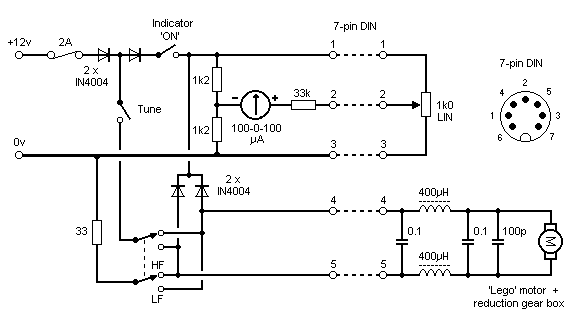| Remotely
Controller Tuner
|
| The circuit shown above was devised to
provide a method of fine-tuning the experimental vertical antenna. This
remotely-controlled tuner has enabled me to change frequency much more quickly than
previously, when I only had the larger variometer with which to make such adjustments.
(Not easy with an upstairs shack; and the loading coil/variometer positioned in the
garden!) The potentiometer (having a 1/4 inch spindle) is mounted at one end of the axle and acts as both an end-bearing, and a detector of variometer position. The driven end of the axle passes through the former of the outer inductor and is glued to a large pulley wheel. Short pieces of cord are tied to the pulley wheel to limit the rotation of the spindle to +/- 90 degrees, thereby protecting the slider of the potentiometer from damage. The pulley wheel (actually, it is a plastic wheel from a discarded push-chair) is belt driven by a 'Lego' motor and reduction drive built by my son, Trevor. |
 |
Built into a plastic
storage box measuring 435 x 445 x 210 mm, the unit includes a wideband matching transformer having a 50 ohm primary winding and
secondary taps at 50; 75; 100; 130; and 160 ohms. The variometer provides an
inductance swing of 135 - 300 uH. |
| At 136 kHz,
with a 12 m antenna, a tuning range of about +/- 500 Hz was achieved when it was
positioned alongside my old Mark I loading coil - more
than enough to cope with short-term variation in antenna resonance. When used underneath
my new Mark II loading coil, I now obtain a tuning range
of +/- 1000 Hz. Click on the thumbnails below for a more detailed look at the construction. |
|


